The next-gen MacBook Pro with Retina Display Review
by Anand Lal Shimpi on June 23, 2012 4:14 AM EST- Posted in
- Mac
- Apple
- MacBook Pro
- Laptops
- Notebooks
The King of All Notebook Displays
For years Apple has been shipping some of the best displays in consumer notebooks, but the MacBook Pro’s Retina Display is in a league of its own. While I never liked the phrase “painted on” in reference to the iPad and iPhone Retina Displays, that’s the best way I can describe the effect the MacBook Pro’s Retina Display has on me. Text really does look painted on. The effect is really the result of two things.
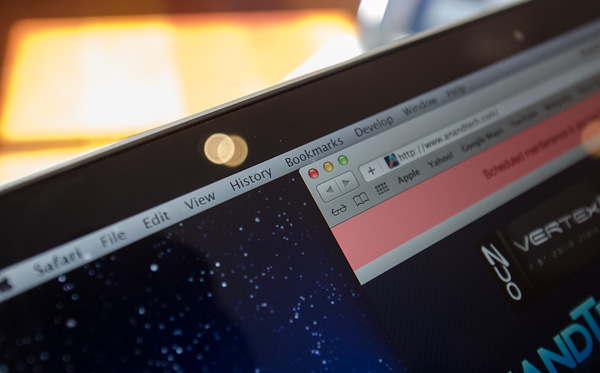
The first is Apple’s removal of its cover glass. LCD panels aren’t particularly attractive, they are ugly squares composed of two pieces of glass and a number of filters/polarizers. To hide the ugly edges, display makers wrap bezels around the display. Most people aren’t fond of bezels so next came a ton of effort to minimize bezel size. An alternative is to simply place a third piece of glass over the entire LCD assembly and make it look as if the bezel and LCD panel are integrated. This outermost layer is known as a cover glass and is what Apple uses on all of its glossy displays. If you’ve ever taken apart a Cinema/Thunderbolt Display or a newer iMac you’ll know that the cover glass is literally just a piece of glass that you have to remove with some suction cups.
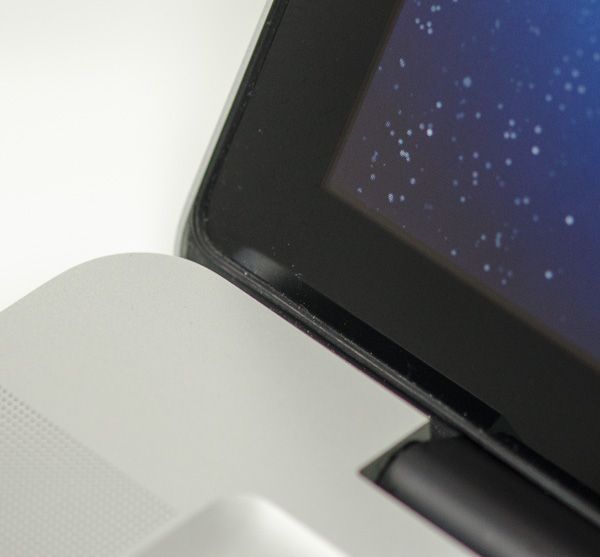
Non-Retina MacBook Pro, notice the gap between the outermost LCD glass and the cover glass
The MacBook Pro’s Retina Display does away with the cover glass and instead uses a fairly unique LCD assembly. There are still two pieces of glass but the outermost glass is actually a different size and shape - it integrates a bezel. By integrating the bezel into the outermost glass in the LCD stack you get the same effect as a cover glass but without the added reflections it introduces.
You also limit the possibility of dust getting trapped between the cover glass and the LCD. The danger is that you no longer have a protective piece of glass in front of your expensive new LCD. If you scratch the display you're scratching the LCD itself. While this has been true for conventional matte displays for a while, it's worth mentioning if you're used to Apple's glossy displays where you did have that added security layer.
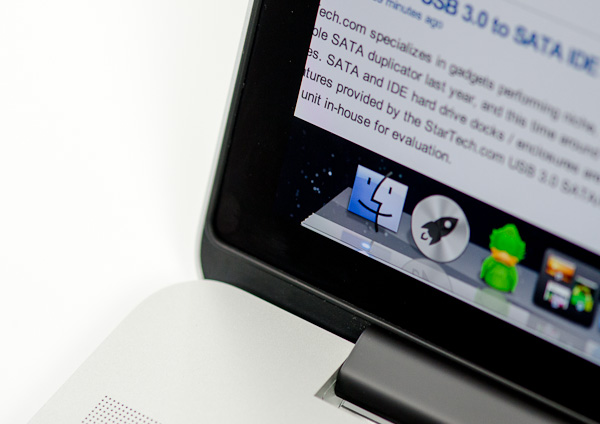
The MacBook Pro with Retina Display, no gap, no cover glass
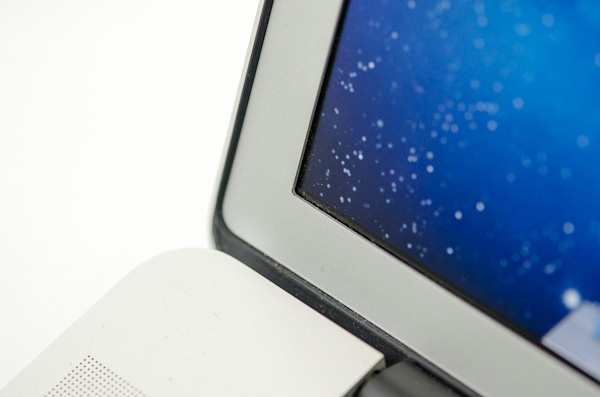
The 2011 MacBook Pro with High-Res Matte display option, no cover glass, top bezel

From left to right: 2010 High Res Glossy MBP, 2012 rMBP, 2011 High Res Matte MBP
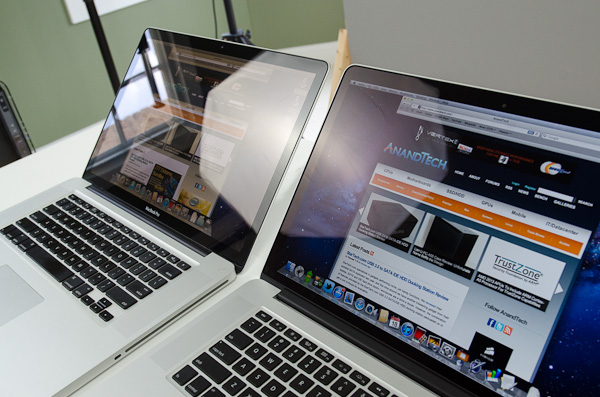
Glare handling indoors - 2011 High Res, Glossy MBP (left) vs 2012 rMBP (right)
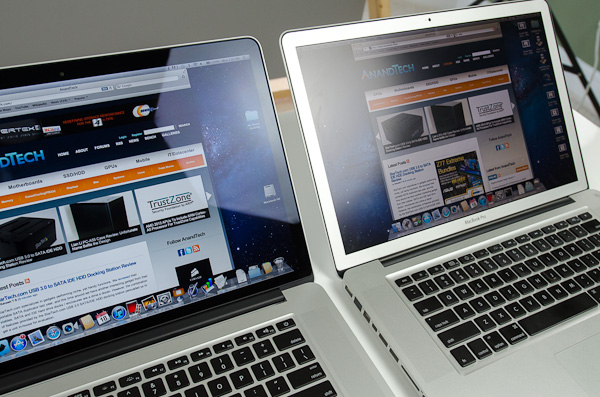
Glare handling indoors - 2012 rMBP (left) vs. 2011 High Res, Matte MBP (right)
The Retina Display is also obviously an extremely high resolution panel at 2880 x 1800. Note that this is 44.6% more pixels than Apple’s 27-inch Thunderbolt Display, and 26.6% more pixels than the 30-inch panels that we’ve loved for so long - all in a 15.4-inch notebook display.
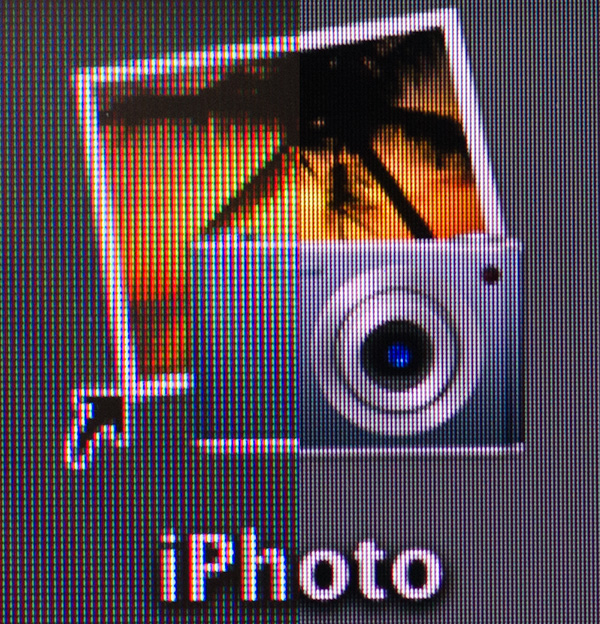
An iPhoto shortcut, High Res 2011 MBP (left) vs. Retina Display MBP (right)
At 220 pixels per inch it’s easily the highest density consumer notebook panel shipping today. At normal viewing distances and even with my face closer than I’m comfortable putting it I simply cannot discern individual pixels.
It’s the combination of these two elements, the removal of the cover glass and the insanely high pixel density that makes everything from text to UI elements just look painted on the new Retina Display. And the effect is gorgeous. I’ve never seen a prettier panel and it’s actually ruined me for pretty much all other displays, notebook and desktop.
While I can appreciate the iPad’s Retina Display, the impact from the MacBook Pro’s display is even more significant. Perhaps it’s because I still spend so much time working on a standard, non-tablet display, but I’m far more excited about this display than anything else Apple has delivered under the Retina moniker.
It’s not just pixel density that Apple has to offer here. Similar to its Retina Displays in the iPhone and iPad, the MacBook Pro’s Retina panel ditches TN in favor of IPS technology. The result is an incredible improvement in viewing angles. On a notebook I don’t spend a lot of time viewing it from far left/right angles, although I see the benefit when I’ve got others huddled around my display. Here the panel performs admirably - you lose brightness at far left/right angles but there’s no perceivable color shift. In fact, the painted on effect is even more impressive at these far left/right viewing angles.
For a single user however the more impressive characteristic is just how good the display looks at vertically off-center angles. I wrote much of the initial parts of this review while on an airplane in coach, which with a 15-inch notebook on my lap means I’m going to be looking at the display at a weird angle to begin with. The thinner rMBP doesn’t do enough to make the airplane usage model any better if the person in front of you decides to recline, but the IPS panel does make the display perfectly usable at the off-center angle you’ll inevitably have to deal with.
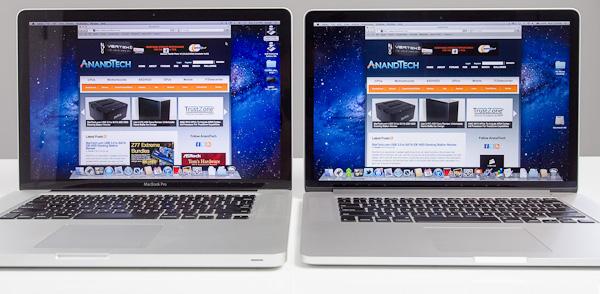
2010 High Res, Glossy MBP (left) vs. 2012 rMBP (right)
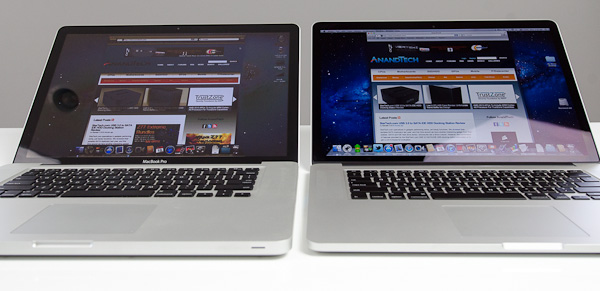
Hello colorshift!
2010 High Res, Glossy MBP (left) vs. 2012 rMBP (right)


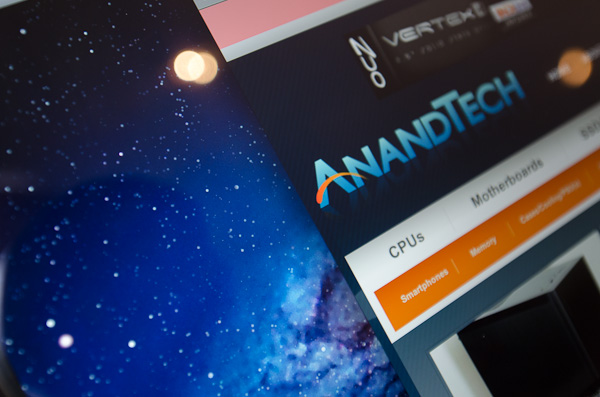
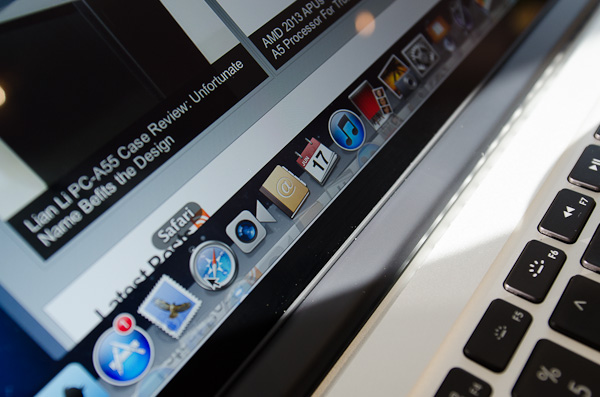
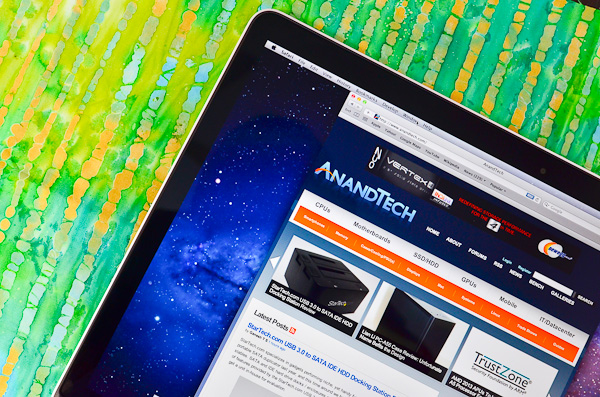
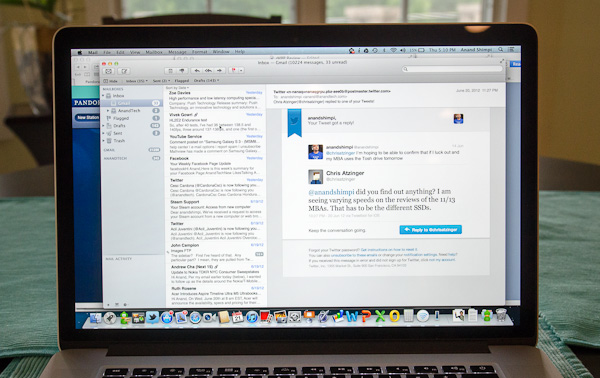
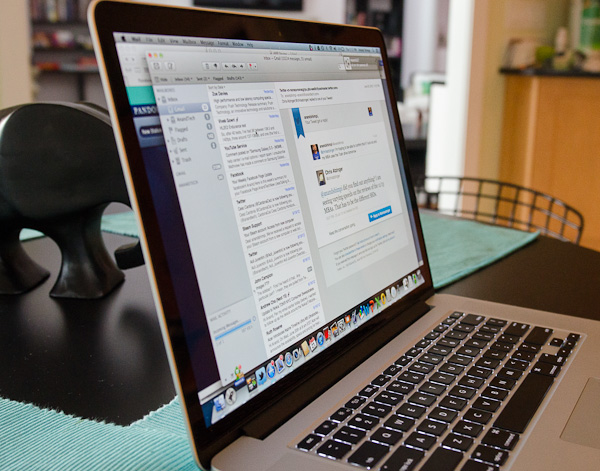








471 Comments
View All Comments
netmann - Saturday, June 23, 2012 - link
Anand, very nice review as always! One picture I was hoping to see is the location of exhaust vents on rMBP. Are the vents similar to MacBook Air discharging hot exhaust air towards the hinge, or are the vent similar to Asus Zenbooks exhausting the hot air through angled grille towards the screen? ThanksMarburg U - Saturday, June 23, 2012 - link
Customers really didn't care about displays.Customers have always payed attention or tho the price or to the brand (and that's an exlusive or). And they are doing the same right now. And they will continue doing so in the future.
I've never bought an Apple product. But i will always be thankful to Apple because they make niches profitable and transform those tiny places in big markets.
tipoo - Saturday, June 23, 2012 - link
It's now known this is the first MBP that can use three external displays via the two TB ports and HDMI. However I'm a bit sceptical as this review says things can get choppy even just on its own one display, I'm curious how it does with four.kidconcept - Saturday, June 23, 2012 - link
"The GT 650M is fast enough to drive the rMBP’s 2880 x 1800 panel at native resolution at playable frame rates, around 18 fps on average." (Concerning Diablo 3)I understand that gaming performance is not a concern for most people purchasing the macbook pro, but I think the review of the GPU is downright misleading. The review glosses over higher performance GPU's available on the market, and fails to identify the 650 as a middling performance current gen GPU. The benchmarks are all against older generation GPU's from previous apple products and all in games that aren't demanding performance-wise. What's missing is the top end of the chart and it gives a misleading perspective on the capabilities of this machine.
Don't get me wrong, I would love to own one of these devices. But I think that if you happened to wander in to buying a rMBP hoping to get good gaming performance, you are going to be disappointed.
wfolta - Saturday, June 23, 2012 - link
The quote you have from the article addresses exactly your point. The rest of the GPU info is for people who would be comparing this to previous models, while the quote addresses game playing. As you say, the primary audience for this machine is not hardcore gamers.The 650 is "middling" only compared to chips that appear in gaming laptops that generally weigh twice as much and are twice as thick as the rMBP, which means they're simply not comparable machines.
I'd add that in Diablo III, Normal Act III, I'm getting 20 FPS when battling a few dozen mobs, and more than that otherwise. That's with most settings turned up (I think a couple default to "Medium"), 2880x1800 with AA. I haven't had a chance to experiment with using a lower resolution (1440x900) without AA, but I've read that frame rates to increase substantially. Not bad for an ultrabook.
sheh - Saturday, June 23, 2012 - link
Would be interesting to know how fast the display is. Pixel response times, lag, RTC, etc.frabber - Saturday, June 23, 2012 - link
Given that Lenovo ships with 170W for "similarly" equiped w530 (cpu 3720qm, gpu k2000m) ?Is that 85 watt really sufficient, how does that work?
umesh - Saturday, June 23, 2012 - link
The price for the higher end rMBP is $ 2799, and not $ 2699 as given in the article.Ryan Smith - Saturday, June 23, 2012 - link
Not sure how that ended up in there...Thanks for the heads up. Fixed.
name99 - Saturday, June 23, 2012 - link
"Perhaps I was being too aggressive in the prediction of a couple of high bandwidth ports. After all, the next-generation MacBook Pro with Retina Display features four such IO ports (2 x Thunderbolt and 2 x USB 3.0). But you get my point. Gigabit Ethernet and Firewire 800 are both gone. "You were too aggressive, but I think the point remains, and remains valid. I look at the rMBP and what strikes me ("irritate" is too strong) is the existence of the HDMI port --- I don't want that and would rather have a 3rd USB3 port or TB port. And I think this is everyone's feeling --- you MUST have an HDMI port, the guy over there MUST have an ethernet port.
If we could get to the point where
- the device comes with 4TB ports,
- a large number of reasonably priced TB devices exist, and
- a rich set of backward adapters exist (like the, IMHO reasonably priced, Apple ethernet adapter)
we'd all be better off.
Personally I have no idea what Apple and Intel thought would be usefully achieved by keeping TB Apple exclusive for a year, but now that that's over, it will be interesting to see how this plays out.
I do think the path the rMBP has taken (no ethernet, but LOTS of IO available in principle, and with Apple showing how that is useful for ethernet) is a good start, and makes the rMBP that much more desirable a machine --- almost a laptop with slots. But the PC vendors are all in such a screwed up state these days --- making no profit competing with Apple, terrified that MS is stealing their business, uncertain where Android is going --- that I fear none of them is willing to do anything aggressive to try to compete with Apple in this space. Will we see a high end Lenovo or Sony machine that tosses its obsolete ports for TB? Hmm. Given that these vendors seem to believe it makes sense to retain the VGA port, I suspect not.
The lack of TB hubs, for example, strikes me as a real problem. (To the extent that if I were Apple or Intel, with a strategic interest in pushing this technology I'd be selling my own --- 3rd party vendors have been given over a year to step up to the plate and have not delivered.)